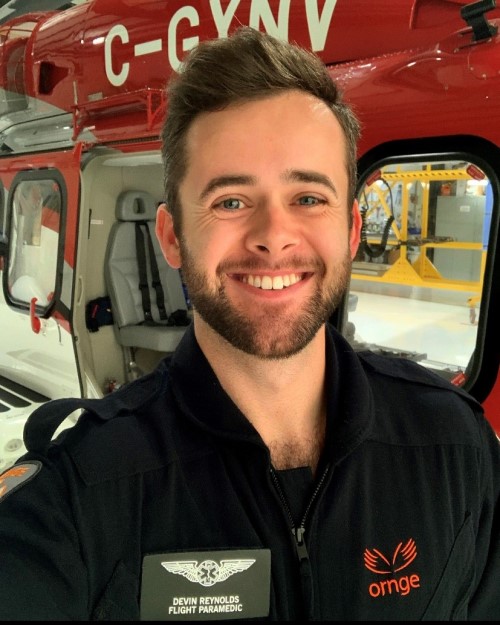COVID and the Flight Paramedic
 Every now and again, especially if you live near a flight path in the province of Ontario, you’ll hear the familiar whirr of a helicopter or the drone of a small, fixed wing aircraft overhead. Look up, and sometimes you’ll see that what’s flying overhead is also painted bright orange. To those who may not be familiar, what you’re looking at is one of Ontario’s fabled air ambulance and critical care transport crews doing their job – transporting critically ill people to the care they need, or in some cases transporting the care to them.
Every now and again, especially if you live near a flight path in the province of Ontario, you’ll hear the familiar whirr of a helicopter or the drone of a small, fixed wing aircraft overhead. Look up, and sometimes you’ll see that what’s flying overhead is also painted bright orange. To those who may not be familiar, what you’re looking at is one of Ontario’s fabled air ambulance and critical care transport crews doing their job – transporting critically ill people to the care they need, or in some cases transporting the care to them.
The early days of COVID were very different for advanced care flight paramedics like Devin Reynolds and his colleagues. Every year Ornge (which also operates land transport in addition to their flight duties), performs approximately 20,000 patient transports. Most of these are inter-facility patient transfers -- something that became very common during the third-wave of the COVID pandemic as some regions’ Intensive Care Units overflowed with COVID patients.
In February 2021, Ornge launched something called Operation Remote Immunity to ensure members of the indigenous community were able to have access to the Moderna vaccine. Hundreds of residents in the remote northern regions of the province live in “fly-in” communities where access to health care is limited. When it comes to vaccination, it can be challenging because of geography, resources and cultural differences related to health care. Recognizing the critical important of engaging Indigenous leadership in how vaccines are offered to their communities, the plan was co-developed through a partnership with Nishnawbe Aski Nation (NAN) and Ornge.
“It was an honour and a privilege to be a part of that operation,” he says, recalling how exhausted he was after working long night shifts for days on end. “The pandemic took a toll on all of us in different ways, and we saw seen things we’d never seen before, for sure. To be a part of a team that brought hope to those living in remote northern communities was gratifying. So often we are involved only when there are problems or issues for patients who need higher levels of care. It was great to play a role in mitigating the spread of the virus.”
Overall Operation Remote Immunity was considered a success with 25,000 doses administered and 90 per cent of eligible people vaccinated in 32 communities.
While Operation Remote Immunity was a health promotion mission, Devin still can’t say enough about the importance of MedicAlert and the impact it had during the pandemic surge across the province. “Sometimes people were unable to explain what was wrong or even share their name,” he says. “And in working with indigenous communities, paramedics often have language barriers.” In those situations, Devin was always relieved if he saw someone wearing a MedicAlert ID.
“Whether they are confused, have an altered level of awareness or are even unable to answer questions, MedicAlert provides us with great insight so that we don’t have to ask questions about past medical history or medications. We can look for the ID, see what’s written on it and, if we have further questions, can call the Emergency Hotline,” says Devin. “It makes our ability to care for the patient that much easier and hopefully results in better outcomes for our patients.”
